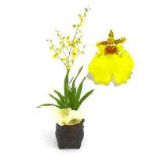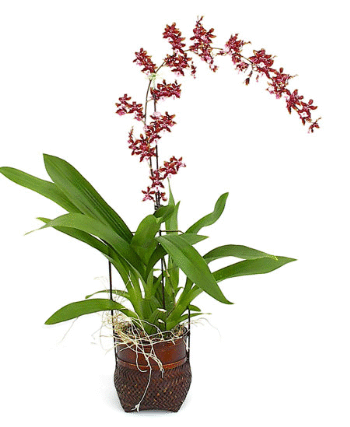Oncidium Orchid: Beautiful Dancing Ladies and Easy To Grow!
Oncidium Orchid At A Glance:
Sympodial Orchid
Light: Medium to High
Temperature: Intermediate
Flowering: Varies
Care: Beginner
Oncidium Orchid Care (Oncidium Alliance and Warm-growing Genera)

General:
ONCIDIUM (Pronounced on-SID-ee-um) is an extremely large and diverse New World genus with at least 330 different species. As such it includes plants form many types of environments. Oncidiums are sometimes known as “Dancing Ladies” or the yellow variants are compared to a swarm of bees. In any case they are lovely, graceful and relatively easy to grow and rebloom.
These varied group of orchids and includes plants from many types of environments including Mexico, the Caribbean and Florida. They are also found in some parts of South America especially in area where there are dry seasons. Some come from hot and dry areas, while others grow in less severe conditions. For more specific growing directions it is best to get direct information from the grower. Some other genera besides Oncidiums that are included in this alliance are Aspsia, Brassia, warm-growing Miltonia and, of course, their hybrids. Because it is so large they come from an equally large set of diverse habitats. This makes it harder to completely generalize about culture. They can be grown both in the home and in a sheltered area in the garden in the right climates. These diverse habitats make it so some consider them easy to grow and some consider them harder to grow.
Oncidium Alliance orchids are becoming more popular for both their ease of growing and the long lasting sprays of flowers. These plants are generally epiphytes which means they grow on other plants like trees but are not parasitic on the other plant. In the wild they derive moisture and nourishment from the air and rain.
An oncidium orchid has pseudobulbs as do some other orchids like Cattleyas. Pseudobulbs are water storage devices for the orchid to store surplus water.
Oncidium Orchid Light: The light needs can vary from bright to nearly full direct sun depending on the particular species. Thicker leaved types like the mule ear Oncidiums generally need more light than thin-leaved ones.
GIVE: Bright light, some sun. In the greenhouse, 20% -60% shade.
Oncidium Orchid Temperatures: Temperatures for this group are generally more tolerant of a wide range of temperatures, except extreme cold. They are considered intermediate to warm growing orchids with 55-60 degrees F. (13-15 C.) at night and 80 – 85 F. (27 -30 C. during the day. Temperatures in some situations are tolerated up to 95 – 100 F. (35 – 38 C.) if the humidity and the air circulations is increased as the temperatures rise.
GIVE: 55-60 degrees F. (13-15 C.) at night and 80 – 85 F. (27 -30 C.) during the day.
Oncidium Orchid Care Water: Again because this is a large genus the water requirements vary with the type of plant. Generally, plants with large fleshy roots or leaves need less-frequent watering than the thin-leaved or thin-rooted plants. As with most orchids watering should be thorough and plants should dry about half way through the pot before watering again. A good rule of thumb is (except for mounted plants) “When in doubt, go drought.” DO NOT use water that has been water softened as it can kill your orchids. It is important to give the plant a complete drenching when you water. It is best to water early in the day so that the leaves dry out. I water my orchids by putting them in a sink and running water through the pot 3 or 4 times over a 15 minute period. Then if I am going to fertilize I do it then as the roots have swollen somewhat and can absorb the nutrients.
GIVE: Thorough watering, letting mix dry out almost completely.
Oncidium Orchid Humidity: Like most orchid Oncidiums appreciate higher humidity than other house plants. Humidity should be between 30% - 60 %. Most of the Oncidiums require less humidity than some other orchids. Most greenhouses have adequate humidity. In the home, placing the plants in orchid humidity trays is the best way to go. Some people like to increase the humidity by misting (which I am not a big fan of due to the possibility of increased risk of fungal disease) to increase the humidity. Humidity trays function by o putting a plate or saucer with little pebbles in it and put water in it. Put the orchids ABOVE the water. This increases the humidity around the plant. You can also use humidity trays like the ones I sell very effectively. In fact I have almost all my 100+ orchids on these humidity trays. (I only grow orchids in my home.) They are a fabulous orchid growing tool! If you are interested in checking them out further Click here.

Oncidium Orchid Fertilizer: Fertilizer should be applied regularly while plants are actively growing. Fertilize with a balanced formula every two weeks. Many growers use a 30-10-10 formulation on plants in a bark based medium and use a 20-20-20 for other media like cork bark, tree fern, sticks or slabs. I like to go with a dilute formulation at about 1/4 and 1/2 the recommended strength of the dilution. The adage is "weakly, weekly". That said it is best to reduce the amount of fertilizer during the winter months when most plants are not in active growth. Do not fertilize orchids when they are dry. Only fertilize after you have given the plant a good drenching and the “velamen” has had a chance to absorb some water. Velamen, you ask? Velamen is the name of the thick spongy outer layer of cells on the roots of epiphytic orchids that absorbs moisture from the surroundings. That way your plant can properly uptake the nutrients in the fertilizer.
GIVE: Dilute (one quarter strength) of 30-30-30 biweekly during active growth. 10-30-20 when approaching bloom.
Oncidium Orchid Repotting: Best to repot when the new growth begins from the base of the plant and is about one half mature which is most often in the spring. For potting in pots a finer grade potting medium is usually used with the fine rooted plants and the courser medium is used with the larger rooted plants. As a standard, the medium size is used. When using a pot I fill the pot with about a quarter to one inch with drainage material, either rocks or pot shards or Styrofoam “peanuts”. Position the plant in the pot so that the newest growth(s) are the farthest edge of the pot. Spread the roots over a cone of the potting medium and fill in around the roots with the potting medium. I like to use a chopstick to do this. When repotting now is a good time to remove any dead or rotting roots. If you do cut them use a sterile razor blade or sterile technique to do so.
Equitant and mule-ear Oncidiums as well as the other larger fleshy-leaved and larger rooted plants can be grown very effectively on cork bark or tree fern or in pot with a coarse well drained medium. This will provide the drying between watering that help these kinds to thrive.
I hope this article has been helpful to you to understand these lovely orchids better. If you are interested in the culture for other kinds of orchids please check this page.


